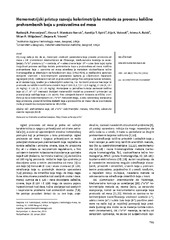Chemometric approach in the development of the colorimetric method for the estimation of food colorants in meat products
Hemometrijski pristup razvoju kolorimetrijske metode za procenu količine prehrambenih boja u proizvodima od mesa
| dc.creator | Petronijević, Radivoj B. | |
| dc.creator | Matekalo-Sverak, Vesna F. | |
| dc.creator | Spirić, Aurelija T. | |
| dc.creator | Vuković, Ilija K. | |
| dc.creator | Babić, Jelena A. | |
| dc.creator | Milijašević, Milan P. | |
| dc.creator | Trbović, Dejana | |
| dc.date.accessioned | 2020-12-01T10:40:41Z | |
| dc.date.available | 2020-12-01T10:40:41Z | |
| dc.date.issued | 2014 | |
| dc.identifier.issn | 0367-598X | |
| dc.identifier.uri | https://doaj.org/article/f460c6a87a58418d8fcfba2fd81be88a | |
| dc.identifier.uri | https://vet-erinar.vet.bg.ac.rs/handle/123456789/1891 | |
| dc.description.abstract | The aim of this research was to develop a novel colorimetric method based on mathematical models, by multiple linear regression (MLR), from the CIE L*a*b* measurements and data of the HPLC determination of food colorants. Calibration set of 10 production batches of finely grinded cooked sausage with food colorants added was manufactured in industrial conditions as follows: one control batch and 9 products with various quantities of added food colorants: E120 (3.4, 7.5 and 12.5 mg/kg), E 124 (5.0, 15.0, 25.0 mg/kg) and E 129 (5.0, 15.0, 25.0 mg/kg). The estimation of the added food colorants was assessed by measuring L*, a*, b* parameters of cross-section. The quantification of food colorants was achieved by HPLC-PDA. Food colorants were extracted from meat products using Accelerated Solvent Extraction (ASE). Quantification of food colorants was achieved in the range from 1 to 100 mg / kg, and recovery values were from 76.15% to 107.04%, for E 120, from 97.61% to 101.03%, for E 124 and from 99.91% to 101.67%, for E 129. Correlation of the results obtained using HPLC and colorimetric measuring data was assessed by Multiple Linear Regression (MLR). The results from colorimetric and chromatographic determinations in four experimental batches (three batches with different quantities of food colorants and one control batch) were used for calibration. Coefficients of determination (R2) for linear models in experimental batches were 0.954, for E 124, 0.987, for E 120 and 0.993, for E 129. Correlation functions of food colorant quantities and corresponding L*a*b* values were established. The obtained mathematical models were tested for the estimation of the content of dyes in 21 samples of finely grinded cooked sausages purchased in retail stores. Food colorants were confirmed in 20 samples (95.24 %), and one sample (4.76 %) did not contain any of these compounds. Out of the positive samples, sixteen samples (80.00 %) contained E 120, while four samples (20.00 %) contained E 129. Food colorant E124 was not established in any of the analyzed samples. Colorimetric CIE L*a*b* method might be used during sensory evaluation of meat products for the assessment of the added food colorants. | en |
| dc.description.abstract | Cilj ovog rada je bio da se, merenjem vrednosti parametara boje preseka proizvoda od mesa u CIE (Commission Internationale de l'Eclairage, Međunarodna komisija za osvetljenje) L*a*b* prostoru (L* – svetloća, a* – udeo crvene boje i b* – udeo žute boje) ispita mogućnost procene sadržaja dodate prehrambene boje u proizvodima od mesa. Količina prehrambene boje u uzorcima od mesa određena je metodom visokoefikasne tečne hromatografije sa detekcijom na fotodiodnom sloju (HPLC-PDA), a međusobna zavisnost dobijenih vrednosti i kolorimetrijskih parametara ispitana je višestrukom linearnom regresijom (MLR). Kalibracioni set od 10 proizvodnih partija fino usitnjene barene kobasice, sa tri dodate boje, izrađen je u industrijskim uslovima, i to: kontrolni proizvod bez boje i 9 proizvoda sa različitim količinama dodatih boja E 120 (3,4; 7,5 i 12,5 mg/kg), E 124 (5, 15 i 25 mg/kg) i E 129 (5, 15 i 25 mg/kg). Postavljene su jednačine funkcije zavisnosti količine boje od L*, a* i b* vrednosti. Dobijeni matematički modeli su provereni i primenjeni za procenjivanje sadržaja boje u 21 uzorku fino usitnjenih barenih kobasica sa tržišta. Utvrđeno je da se kolorimetrijskom CIE L*a*b* metodom mogu, u toku senzorskog ocenjivanja boje proizvoda, proceniti količine dodatih boja u proizvodima od mesa i da se ova metoda može primeniti kao komplementarna HPLC-PDA. | sr |
| dc.language | sr | |
| dc.publisher | Savez hemijskih inženjera, Beograd | |
| dc.relation | info:eu-repo/grantAgreement/MESTD/Integrated and Interdisciplinary Research (IIR or III)/46009/RS// | |
| dc.rights | openAccess | |
| dc.rights.uri | https://creativecommons.org/licenses/by-nc-nd/4.0/ | |
| dc.source | Hemijska Industrija | |
| dc.subject | prehrambene boje | sr |
| dc.subject | CIE L*a*b* kolorimetrijska metoda, | sr |
| dc.subject | HPLC-PDA | sr |
| dc.subject | višestruka linearna regresija (MLR) | sr |
| dc.subject | food colorants | en |
| dc.subject | CIE L*a*b* colorimetric method | en |
| dc.subject | HPLC-PDA | en |
| dc.subject | MLR | en |
| dc.title | Chemometric approach in the development of the colorimetric method for the estimation of food colorants in meat products | en |
| dc.title | Hemometrijski pristup razvoju kolorimetrijske metode za procenu količine prehrambenih boja u proizvodima od mesa | sr |
| dc.type | article | en |
| dc.rights.license | BY-NC-ND | |
| dcterms.abstract | К, Трбовић Дејана; Б, Петронијевић Радивој; Ф, Матекало-Сверак Весна; Т, Спирић Aурелија; К, Вуковић Илија; A, Бабић Јелена; П, Милијашевић Милан; Хемометријски приступ развоју колориметријске методе за процену количине прехрамбених боја у производима од меса; Хемометријски приступ развоју колориметријске методе за процену количине прехрамбених боја у производима од меса; | |
| dc.citation.volume | 68 | |
| dc.citation.issue | 6 | |
| dc.citation.spage | 781 | |
| dc.citation.epage | 791 | |
| dc.citation.rank | M23 | |
| dc.identifier.wos | 000348405900012 | |
| dc.identifier.doi | 10.2298/HEMIND131204004P | |
| dc.identifier.scopus | 2-s2.0-84920476916 | |
| dc.identifier.fulltext | https://vet-erinar.vet.bg.ac.rs/bitstream/id/5021/Chemometric_approach_in_pub_2014.pdf | |
| dc.type.version | publishedVersion |

